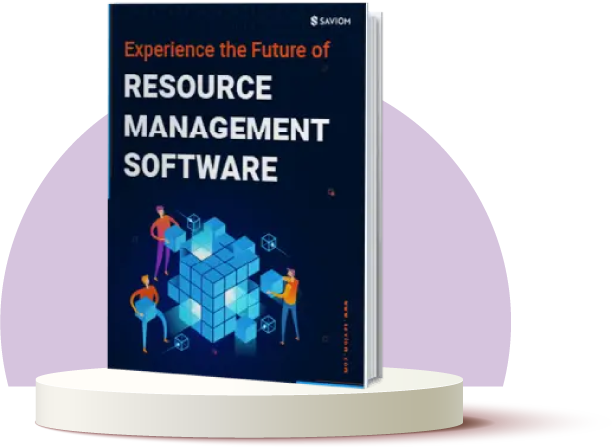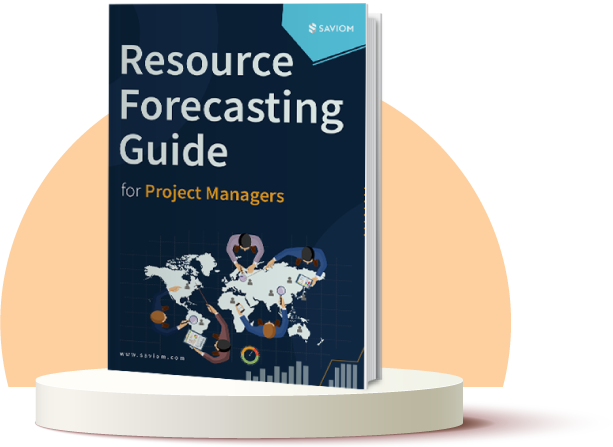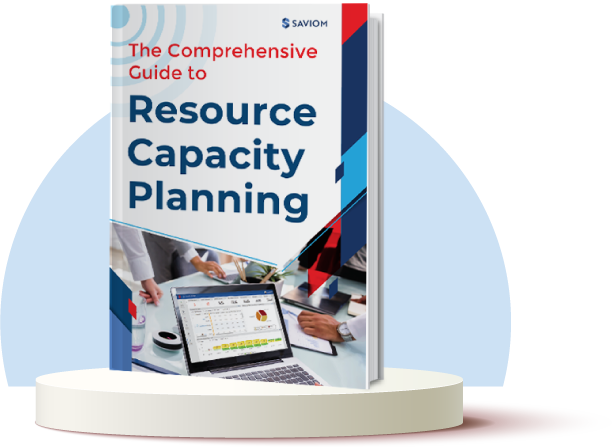Resources are the most significant investment of any company. Therefore, managing resources effectively enables businesses to stay sustainable and profitable in the long run. However, it is not as easy as it sounds. The entire resource management process comprises a plethora of activities.
It’s imperative for organizations to streamline critical resource-centric functions such as capacity planning, resource allocation, and utilization tracking to make every project successful. Any disruption can cause issues such as budget overruns and project delays, resulting in client dissatisfaction.
This is where the role of a resource manager becomes critical for the success of any organization. They ensure that the right resource is allocated to the right project and not overutilized.
This blog discusses the characteristics of a successful resource manager. But first, let’s start by defining:
What is a resource manager, and why are they important?
A resource manager is responsible for allocating all the resources under their span of control to various projects. These resources can be human resources, assets, equipment, facilities, etc. For a large organization, the average number of resources under a resource manager’s span of control can vary from 200 to 500.
Typically, when a project manager raises resource requests, the resource manager assesses the enterprise resource pool. They then allocate the best resource matching the demand criteria of the project.
Besides competent allocation, a resource manager also ensures improving productive utilization, bridging the skill gaps, effective bench management, etc.
Resource managers play a vital role in project success, and by extension, they contribute significantly to organizational success. They support a firm’s strategic objectives and goals by facilitating the following functions:
Resource planning and demand forecasting:
Resource managers work closely with project managers and department heads to develop resource plans and forecasts to determine project resource needs. This proactive planning ensures that the right resources are available at the right time, minimizing bottlenecks and avoiding resource shortages.
Efficient resource allocation:
Resource managers allocate resources effectively to various projects, departments, and teams. They ensure that human and non-human resources are distributed in a way that maximizes productivity and minimizes waste. This efficient allocation helps in achieving organizational goals within budgetary constraints.
Resource optimization:
Resource managers oversee, track, and optimize resource utilization. They identify under/overutilization and take corrective actions to mitigate it. By balancing workload distribution, resource managers improve profitable utilization and workforce productivity.
Conflict resolution:
Resource managers often face challenges related to resource conflicts and competing demands. They mediate disputes arising from overlapping resource requirements and negotiate compromises or alternative solutions. Their role involves prioritizing projects, resolving resource clashes, and maintaining a fair and equitable distribution of resources across the organization.
Performance monitoring:
Resource managers monitor resource performance and evaluate the effectiveness of resource allocation strategies. They analyze key resource metrics, such as resource capacity, availability, utilization, etc., to identify improvement areas and optimize strategic decision-making.
Risk management:
Effective resource management involves identifying and mitigating resource-centric risks. Therefore, resource managers proactively assess potential risks, develop contingency plans, and ensure backup resources are in place. This enables the organization to minimize disruptions and maintain operational workflow.
Cross-departmental collaboration:
Resource managers act as a bridge between different teams, departments, and stakeholders within the organization. They facilitate communication and collaboration by sharing resource-related information, coordinating resource needs, and resolving conflicts. This promotes synergy among various parties and ensures successful project delivery.
In summary, their efforts contribute to effective planning, improved performance, and the overall success of projects and initiatives.
Next, let’s learn about the consequences of not hiring a resource manager.
Read More: What is Resource Management? A Comprehensive Guide for All
What can go wrong if businesses don’t invest in resource managers?
The success of every project depends on the resources that are allocated to the tasks. Resource managers are responsible for the efficient allocation of resources. Furthermore, they deploy those resources based on their capacity, skills, and experience.
Thus, if companies don’t invest in resource managers, it may result in sub-optimal resource allocation and planning. Ultimately, it will lead to project failures, hamper the company’s reputation, and result in client dissatisfaction. Moreover, resource managers ensure that resources are utilized on billable or strategic work at all times. When a resource gets rolled off from a project, the resource manager acts proactively and assigns him to suitable work before he/she hits the bench.
Lastly, resource managers forecast the future availability of resources and bridge the resource gaps in advance. They identify the shortage/excess of resources and take appropriate measures to fulfill the demand. In the absence of resource managers, businesses may face lost market opportunities and find it hard to sustain amid market volatility.
In a nutshell, the whole resource management structure will get negatively affected if businesses don’t invest in resource managers. Modern resource management software helps resource managers streamline their responsibilities and enable companies to gain a competitive edge.
Let’s learn about the key responsibilities of a resource manager within an organization.
Read More: Resource Manager vs. HR Manager: What Are Their Roles & Responsibilities?
What are resource manager’s responsibilities?
A resource manager needs to fulfill certain key responsibility areas to execute the above-mentioned activities and prove their mettle.
Here’s a rundown of the essential resource manger responsibilities.
Assigning resources to projects as per competencies and skills
Every project demands different skill requirements, and misalignment in resource competencies and demand can impact its quality or timeline. For example, assigning a critical or highly specialized resource to a routine task causes budget overrun, lower engagement, and productivity. On the contrary, allocating an under-skilled resource to skill-intensive tasks hampers the project’s progress and delays the deadlines.
Thus, the vital role of a resource manager is to diligently assess each project’s requirements, resource availability, skills, and competencies so that allocations align with the attributes of resources. It allows them to achieve competent allocation and eliminate future project bottlenecks.
Helping project managers with resource capacity planning for pipeline projects
A resource manager has to coordinate with the project manager to stay abreast of future resource requirements for pipeline projects. They first foresee the resource demand and assess the available capacity to find any existing gap between them. In case of shortage or excess of resources, they can proactively implement certain resourcing treatments.
They can analyze on-the-bench reports, implement the out-rotation and backfill strategy, or go for planned hiring to proactively fill the project vacancies. In case of excess capacity, the resource manager can request the project manager to bring forward project timelines or organize training programs for upskilling of employees. They can also collaborate with various functional managers and allocate resources to cross-disciplinary projects. In some cases, RMs can sell the excess capacity to external organizations.
Tracking resource utilization, workload, and overtime
The onus lies on resource managers to maintain the resource health index. Thus, they have to track utilization levels to ensure that every resource works on billable or strategic projects. Another job that falls under their responsibility areas is evaluating their workload and distributing it uniformly to prevent over/underutilization.
If resources are overutilized, RMs can pull in more resources to redistribute the work, make utilization levels uniform, and prevent employee burnout. For underutilized resources, finding some billable or strategic work to assign them to can help enhance productivity.
Read More: How to Track Resource Utilization?
Collaborating within departments for resource requirements
Although resource management is an independent discipline, it demands coordination between resource managers and other leaders or supervisors of the organization. For instance, to understand the project demand and objectives, a resource manager has to collaborate with project managers or PMOs. Otherwise, it will become arduous for them to find the ideal fit for the job.
They also have to stay in constant touch with PMOs to understand the project’s criticality before the fulfillment of requests. Moreover, to bridge skill gaps or resource crunch, they have to coordinate with HR managers to streamline the recruitment process. They also coordinate with RM to initiate suitable upskilling programs.
Creating a learning and development roadmap for resources
“Gartner’s recent research reveals that 58% of the global workforce needs new skills to get their jobs done.”
This stat highlights the value of constant training and upskilling of resources in retaining a competitive edge and high productivity.
A resource manager, thus, has to stay updated with evolving industry trends and skill demands. It is also vital for them to take resources’ personal interests and aspirations into account.
Accordingly, they must identify skill gaps and formulate a personalized learning and development program to future-proof their workforce. This way, they avoid frequent hiring and firing, save resource costs, and boost employee engagement and productivity.
Effectively manage bench and implement corrective measures
Bench refers to employees who are not allocated to any project, which means they are non-billable but on a company’s payroll. A resource manager needs to constantly track bench size using a resource management tool to ensure it doesn’t exceed the threshold. If resource managers foresee project ramp-downs, they have to find suitable project vacancies to allocate them before they hit the bench.
Besides, they also implement appropriate resourcing treatments such as training or upskilling for the benched resources to utilize them effectively. Additionally, providing shadowing opportunities to engage freshers and assigning senior employees to strategic work or training juniors falls under the radar of resource managers’ responsibilities.
Read More: How Can Retraining/Upskilling Future-Proof Your Workforce?
To accomplish these KRAs, resource manager needs to equip themselves with appropriate professional management skills.
Here are the most important ones.
Skills required to become a successful resource manager
Resource managers need to be equipped with essential management skills to perform their duties effectively. Let’s take a look at the basic human resource management skills necessary to be a proficient resource manager.
High-level domain knowledge
Though there is no fixed criterion for it, a basic level of domain knowledge is helpful. It helps a resource manager relate to the basics, technologies involved, areas of application, and more for a particular industry. A seasoned resource manager can sometimes switch to even another industry with some basic training and conceptual learning.
Having said that, in-depth knowledge of a particular industry is highly beneficial – especially for someone looking to start their career in resource management. Let’s say a software developer with over ten years of experience wants to become an IT resource manager. They will definitely get the advantage of that knowledge of the nitty-gritty of the software industry and excel at their performance.
Task prioritization and quick decision-making
A resource manager must exhibit the acumen to prioritize projects based on return on interest, value proposition, and other factors. Critical resources, if allocated to a low-priority project or a less skill-intensive project, will increase costs. Conversely, their absence in high-priority projects may lead to compromised quality and client dissatisfaction.
So, a resource manager must streamline the allocation of highly skilled or experienced resources to projects. Besides, they should be able to make prompt decisions on using suitable resourcing measures to fill significant gaps in capacity vs. demand.
Read More: How Resource Optimization Boosts Task Management?
Proven experience in resource planning and management
Resource managers must have a proven track record and sufficient experience in the resource management space of a specific domain. They must have in-depth knowledge of critical components like resource planning, pipeline project planning, etc.
It is also indispensable for a resource manager to be proficient in tracking resource utilization levels to identify any instances of over/underutilization and take measures and eliminate them.
Monitoring, reviewing, and controlling resource metrics, including bench aging, fill rate, project vacancies, etc., is one of the prime responsibilities of RM. Moreover, the ability to understand and handle the complexities involved in a matrix organization is equally necessary.
Quick problem-solving and negotiation skills
Key resources are often in high demand across different projects within an organization. Hence, resource managers must equip themselves with management skills such as quick problem-solving skills to resolve power conflicts between project managers. For example, let’s assume that two projects are starting simultaneously, and both project managers request the same-skilled critical resource. In this scenario, the RM will first assess the project’s priority and allocate the resource to the one that takes precedence.
Then, to fulfill the other project’s demand without creating conflict, they can negotiate with the respective project manager. They can explain how a less experienced resource with a similar skillset can do the job well. Similarly, they can equip negotiation skills in different scenarios to minimize conflicts, fulfill requests, and provide fair opportunities to less experienced resources.
Excellent communication skills with resources and stakeholders
As resource managers are responsible for fulfilling resource requests, possessing excellent communication skills is a must-have management skill for them. It helps them understand the resource requirements of a project manager and convey them to the resources better.
It is crucial for them to identify different resource-related risks like prolonged absence, unplanned attrition, skill gaps, etc. Then, they must convey these risks to stakeholders effectively and prepare a backup plan to mitigate them.
Hands-on experience with resource management tools
Managing resources effectively – especially when working in a large firm, is not possible without a resource management tool. The tool gives 360-degree visibility of resource allocation and multi-dimensional views for resource managers, project managers, etc. It also allows planning, resource forecasting, capacity planning, and scheduling.
Besides, real-time business intelligence reports and dashboards enable data-driven quick decision-making, which helps improve the resource health index. For RMs to perform at their best, it’s imperative to have hands-on experience in resource management tools.
The aforementioned management skill sets are critical attributes that every good resource manager should possess in order to perform their primary roles and responsibilities.
Now let’s take a look at the KPIs that are commonly used to measure the performance of resource managers.
Read More: What is Resource Management? A Comprehensive Guide for All
How to measure the performance of a resource manager?
A resource manager’s performance depends on how efficiently they fulfill their key performance indicators (KPIs).
The following are the primary KPIs to fulfill for a project resource manager.
-
Billable utilization:
Billable utilization of every resource falling under a resource manager’s span of control is one of the main KPIs. The percentage of the resources’ available capacity utilized for billable and strategic work determines their performance.
-
Bench size:
Bench size keeps increasing or decreasing according to constantly changing resource demands. A good resource manager must keep the bench size within a fixed percentage of the available capacity or minimize it.
-
Bench aging:
The number of days a resource is on the bench is called bench aging. Ideally, the bench aging is 0 days. However, in practical scenarios, it should not exceed 90 days. If it exceeds, it indicates an issue with the resource manager’s performance.
-
Fill rate:
The fill rate is measured to determine how efficiently a resource manager can fulfill the resource demand on or before the project begins. If a resource manager assigns the resource as per the demand on or before the start date, the fill rate is considered 100%.
-
Individual development program (IDP):
Every resource has their personal development goals and aspirations regarding their career. It is, therefore, vital for a resource manager to give them enough opportunities to hone soft skills and other technical skills in their respective domains. A resource manager’s performance also depends on how well they cater to everyone’s aspirations and let them advance their career.
Conclusion
As resources are the key investments of a firm, tapping into their maximum potential is highly important. That’s why resource managers are an integral part of determining project and organizational success.
The primary objective of a resource manager is to increase an enterprise’s profitability and sustainability by maximizing the workforce’s profitable utilization and future-proof it to lead the competitive world.
One can become an efficient resource manager by understanding the key responsibility areas and refining the above-discussed resource management skills.
Do you have the skills needed for human resource management? What would your approach be to becoming a good resource manager?
The Glossary
Read More: Glossary of Resource Workforce Planning, Scheduling and Management
The SAVIOM Solution
SAVIOM has over 20 years of experience helping multinational clients manage their resources efficiently and effectively. With over 20 years of experience, this Australian-based MNC has a global presence across 50 countries and has helped 100+ clients meet their specific business goals. Saviom also provides tools for project portfolio management, professional service automation, and workforce planning software. So, SAVIOM can help your business to establish an efficient system geared towards your specific business challenges.










Leave a Reply